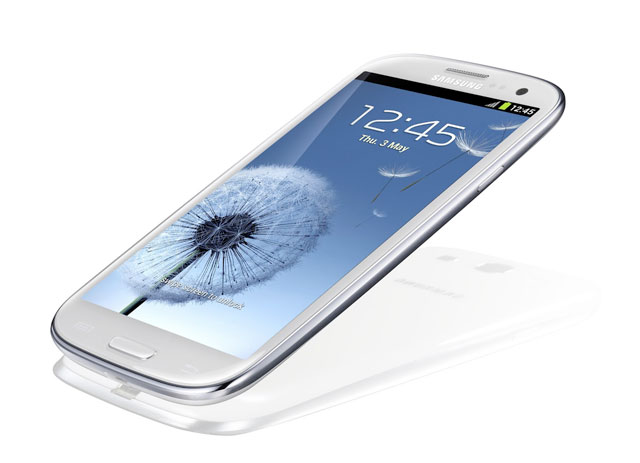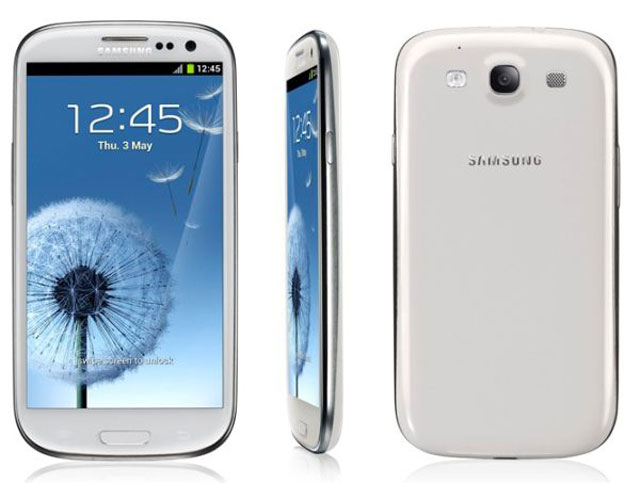
I’ve had two main reactions from people when I’ve shown them the Samsung Galaxy S3. The first is usually to gasp in awe at the size and brilliance of the S3’s 4,8-inch Super Amoled screen. The second is usually to worry if it’s not perhaps just a little too big.
After a week with the device, I can say confidently that, if you use your phone as a handheld computer rather than simply as a means of making calls and sending text messages, then that worry is totally unfounded. From browsing the Web to reading e-books in Amazon’s Kindle app, the advantages of the larger screen real estate quickly become clear. Switching between the S3 and the comparatively diminutive iPhone 4S, with its 3,5-inch screen, there’s no doubt which screen size I prefer. The Samsung wins hands down.
But there’s of course much more to Sammy’s new superphone than the screen. The S3 sets the bar that other smartphone manufacturers are going to have to beat, from both a hardware and software perspective.
Let’s start with the hardware inside this beast. Packing a quad-core Cortex-A9 processor, 1GB of RAM and flash storage options of 16GB, 32GB and 64GB, the S3’s performance is absolutely stellar. It zips between apps and makes light work of the graphical touches Samsung has included in the latest version of its TouchWiz overlay, which of course sits atop Google’s latest version of Android, Ice Cream Sandwich.
Connectivity options are extensive, too. The S3 supports all the latest 3G communications options, including HSPA+ at 900MHz (useful for Cell C customers). Bluetooth 4.0 is standard, along with Wi-Fi up to the speedy “n” variety. DLNA is also included, to make it easy to stream media between supported computers and devices.
The 8-megapixel camera is also very, very good, though not market leading — it’s on a par with the camera in the HTC One X, the S3’s most direct Android rival, but arguably not as good as the 12-megapixel shooter in Sony’s new Xperia S.
There’s zero shutter lag on the S3, which means you’re less likely to miss that fast-moving action shot. It you take a series of pictures, its software can even recommend which of the shots are probably best based on factors such as whether a subject is smiling. There’s also a single LED flash that produces reasonable results in darkened environments, though the camera also features manual ISO settings from 100 to 800 and options to set light metering to decide on exposure of particular elements in a frame — something normally only found on standalone digital cameras.

Video can be shot in resolutions up to 1080p and, like the One X, it’s also possible to take stills at the same time as recording video.
The front-facing camera has a generous 1,9 megapixels — better than most modern smartphones — making it better for vanity shots and video calls.
Then, of course, there’s that 720p high-definition Super Amoled display. Though it’s not as good in bright sunlight as the HTC One X’s Super IPS LCD2 display, the Amoled display serves up slightly deeper blacks and more vibrant colours than its chief rival.
Our review unit was clad in “marble white” — there’s also a “pebble blue” version available, though from pictures we think the white version is the better looking of the two options. The rear cover is a little flimsy and plasticky, though, and is arguably the biggest drawback of the S3. Still, since you’ll be spending most of your time looking at the front of the device, it’s possibly not the deal breaker some reviewers have suggested.
The sides of the phone have remarkably few ports and buttons. The top has a 3,5mm audio jack, the right has the power button and the left the volume rocker, which could have been a little longer. Sadly, there’s no HDMI-out port for hooking it up to big-screen TVs. The front has two capacitive-touch buttons — “back” and “menu” — as well as a large, elongated central “home” button.
Battery life is quite respectable for a phone with a screen this big, which is perhaps not surprising given the enormous 2 100mAh battery. With moderate use, you should get a full day’s use out of it. For heavy use, a car charger or extra battery will come in necessary.
As a phone, the S3 works well, too. The speakerphone quality is excellent and voice quality in calls is superb. But, hey, who is really buying this thing as a phone, right?
Okay, to the software. As with other Android-powered Samsungs, the S3 has the TouchWiz user interface overlay. Though the latest version is an improvement over the S2, it still isn’t quite as polished as Sense 4.0 from HTC. Perhaps I just have a fetish for retro clock widgets.
However, Samsung has added a number of nifty apps to the basic Android operating system, including S Voice, which is meant to rival Apple’s Siri personal assistant. S Voice isn’t a patch on Siri, though. It’s slow and, frankly, not as clever or “witty” as Apple’s assistant. However, it did manage the answer “42” when I asked it about the meaning of life. Both Siri and S Voice are still gimmicky, though. Their usefulness will no doubt increase rapidly in the years ahead as the companies improve their voice-recognition technology.
There are a couple of other nifty apps bundled with the S3, including Video Hub, which offers movies and TV shows for rent or purchase, though the selection is severely limited at the moment. Blockbuster movies typically cost R99 to buy and R19 to rent. There’s also S Memo, for note taking and drawing pictures and S Suggest that suggests apps you may be interested in.
So, the big question is, does the S3 beat the One X? Both are superb phones and lead the Android pack right now. The HTC wins in some respects because it’s cheaper and because it’s a better looking phone in terms of its design — Samsung loses points for the flimsy, plastic back cover. Sense is also better than TouchWiz, but that’s a subjective view. Overall, though, the S3 is the better phone (just) because of its bigger battery, the ability to remove the battery (useful when there isn’t a power source handy) and the software that comes bundled with the device. And — how could I forget? — the S3 has a built-in barometer, great for weather geeks like your reviewer.
It really is a game changer and Apple has its work cut out making sure the next iPhone is better. For now, though, if money is no object and you simply must have the best Android smartphone on the planet right now, then don’t hesitate in buying one. It’s really that good. — (c) 2012 NewsCentral Media
- R7 999 for the 32GB version. The 16GB and 64GB versions are not yet available in SA, and pricing has yet to be announced




